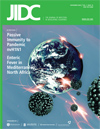Passive immunity to pandemic H1N1 2009 by swine flu parties
DOI:
https://doi.org/10.3855/jidc.395Keywords:
system dynamics, swine flu parties, pandemic H1N1 2009, passive immunityAbstract
The general population is concerned about the probable devastating effects of pandemic H1N1 2009. Based upon the 1918 Spanish flu pandemic, scientific publications and theories, the idea of swine flu parties to achieve passive immunity against pandemic H1N1 2009 has been proposed. Public health officials have asked the general public not to resort to this method. However, no concrete evidence of the reasoning behind the recommendation has been given. In this paper, we have dynamically modeled the effect of swine flu parties on the immunity achieved and associated mortality for a period of two years. The simulations show that the public should not organize or participate in swine flu parties as they will likely increase swine flu-associated mortality.Downloads
Published
2009-11-05
How to Cite
1.
Aggarwal N, Aggarwal P (2009) Passive immunity to pandemic H1N1 2009 by swine flu parties. J Infect Dev Ctries 3:739–743. doi: 10.3855/jidc.395
Issue
Section
Emerging Problems in Infectious Diseases
License
Authors who publish with this journal agree to the following terms:
- Authors retain copyright and grant the journal right of first publication with the work simultaneously licensed under a Creative Commons Attribution License that allows others to share the work with an acknowledgement of the work's authorship and initial publication in this journal.
- Authors are able to enter into separate, additional contractual arrangements for the non-exclusive distribution of the journal's published version of the work (e.g., post it to an institutional repository or publish it in a book), with an acknowledgement of its initial publication in this journal.
- Authors are permitted and encouraged to post their work online (e.g., in institutional repositories or on their website) prior to and during the submission process, as it can lead to productive exchanges, as well as earlier and greater citation of published work (See The Effect of Open Access).








